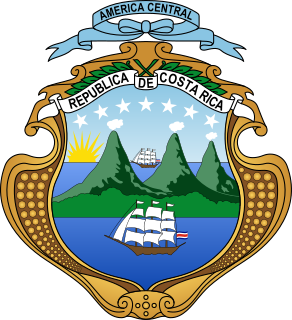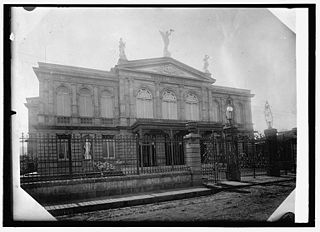
Juan Primitivo Próspero Fernández Oreamuno was President of Costa Rica from 1882 to 1885.

Vicente de las Mercedes Herrera Zeledón was President of Costa Rica from 30 July 1876 to 11 September 1877. He came to power in the coup d'état that deposed President Aniceto Esquivel and resigned in favor of Gen. Tomás Guardia the following year.

Alajuela is the second largest city in Costa Rica. It is also the capital of Alajuela Province.

The 1949 Constitution of Costa Rica established two Vice-Presidencies of Costa Rica, which are directly elected through a popular vote on a ticket with the president for a period of four years, with no immediate re-election. There has been various incarnations of the office. Vice presidents replace the president in cases of temporary or permanent absence.
Apolinar de Jesús Soto Quesada was a Costa Rican politician and soldier. He was born on 23 July 1827 in Alajuela, Costa Rica, to Bernardo Soto Herrera and Josefa Quesada González. He married Joaquina Alfaro Muñoz on 23 April 1849 in Alajuela, with whom he had two children: Bernardo Soto Alfaro, President of the Republic from 1885 to 1890, and José María Soto Alfaro, presidential candidate in 1919.
Ezequiel Gutiérrez Iglesias was a Costa Rican politician.

Saturnino Lizano Gutiérrez was President of Costa Rica from 6 July to 10 August 1882.
Emilia Solórzano Alfaro was the First Lady of Costa Rica during the periods of 1870–1876 and 1877–1882.
The Embassy of Costa Rica in London is the diplomatic mission of Costa Rica in the United Kingdom. The mission was raised to the status of embassy in 1956, having previously been a legation.
Events in the year 1882 in Costa Rica.
After the coup against dictator Jesús Jiménez Zamora on April 27, 1870, and after the brief government of Bruno Carranza Ramírez, Tomás Guardia Gutiérrez succeeded on August 8 and elections were called by the then provisional president Guardia on 8 of May 1872. It was the first time that the presidency was exercised by a military.
The 1876 Costa Rican general election was held on April 2, 1876. Aniceto Esquivel Sáenz was elected president unanimously thanks to the influence of the acting president Tomás Guardia Gutiérrez who practically hand picked him. At that time and according to the Constitution, there were two electoral rounds; first all citizens legally allowed to vote chose electors and then the voters voted for the president.
The 1882 presidential election of Costa Rica in 1882 was the first after a long line of successive de facto governments following the coup against Aniceto Esquivel Sáenz by his former ally Tomás Guardia Gutiérrez. Vicente Herrera Zeledón, Costa Rica's first conservative president, was placed in Esquivel's place, but in practice he was a puppet of Guardia's authoritarian regime. After the brief presidency of Herrera who resigned using health reasons as excuse, the political elite appoints Guardia to replace him. However Guardia died in 1882 and elections were called, which were won by Freemason and liberal Próspero Fernández Oreamuno member of the Olympus Generation, an elite group of liberal intellectuals nicknamed as such due to their arrogance.
The 1886 Costa Rican general election was held on 4 April 1886. After the death of Próspero Fernández Oreamuno in March 1885, Bernardo Soto Alfaro took over the presidency temporarily for the remainder of the term. Soto was a thirty-year-old young man who had to command the country in the war against Guatemala that sought to re-establish the Federal Republic of Central America. Soto was a freemason and liberal, belonging to "The Olympus", a group of liberal intellectuals who would have a great influence on Costa Rican politics and many would hold the Presidency of the Republic.

The First Costa Rican Republic is the name given to the historical period between the proclamation of the Republic of Costa Rica in the 1848 reformed Constitution and the official decree by then President José María Castro Madriz on 31 August 1848 and the Costa Rican Civil War of 1948 which ended with the enactment of the current 1949 Constitution on 7 November 1949 starting the Second Costa Rican Republic.

Liberalism in Costa Rica is a political philosophy with a long and complex history. Liberals were the hegemonic political group for most of Costa Rica’s history specially during the periods of the Free State and the First Republic, however, as the liberal model exhausted itself and new more left-wing reformist movements clashed during the Costa Rican Civil War liberalism was relegated to a secondary role after the Second Costa Rican Republic with the development of Costa Rica’s Welfare State and its two-party system controlled by social-democratic and Christian democratic parties.

It is known as the Liberal State the historical period in Costa Rica that occurred approximately between 1870 and 1940. It responded to the hegemonic dominion in the political, ideological and economic aspects of liberal philosophy. It is considered a period of transcendental importance in Costa Rican history, as it's when the consolidation of the National State and its institutions finally takes place.

The history of the Costa Rican legislature is long and starts from even before its formal independence from the Spanish Empire. Costa Rica is one of the world's oldest democracies, thus, its parliamentary history dates back several centuries.











